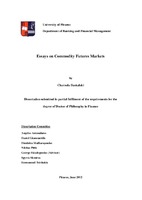| dc.description.abstractEN | The developments in the commodity markets over the last years have attracted the interest of both academics and market participants. In the mid-2000s, both spot and futures prices of a broad set of commodities began to surge after nearly three decades of low and declining prices. The period 2003-2008 has been characterized as a commodity boom because it has witnessed a spectacular and simultaneous increase in the prices of the three major commodity groups (energy, metals, and agriculture, see Figure 1.1). At the same time, investments in commodities have grown rapidly mainly via commodity futures and index funds. The total value of the commodity index-related instruments purchased by institutional investors increased from an estimated $15 billion in 2003 to at least $200 billion in mid-2008 (CFTC, Staff Report, 2008). This phenomenon is usually referred to as the financialization of the commodity futures markets. Commodities have attracted the attention of both individual and institutional investors because they are considered to form an alternative asset class. A number of empirical studies find that commodities exhibit low or even negative correlation with stocks and bonds over certain periods of time and hence diversification benefits are expected to emerge (e.g., Erb and Harvey, 2006, Gorton and Rouwenhorst, 2006). Nevertheless, the recent literature documents that, over the last years, commodities have become more correlated with other financial assets and with each other. This is mainly attributed to the increased presence of index traders in the commodity markets (e.g., Tang and Xiong, 2010). This evidence questions whether diversification benefits from commodity investing hold in practice. Moreover, it motivates investigating whether they are any common factors that explain the cross-section of commodity futures expected returns. | |



